Fun with Species Survival
HEAR IT FROM OUR CONSERVATION YOUTH TEAM
GUIDE TRACK
As our final weeks start to close in, our youth developments are now evolving into conservation messages and projects. For this week, Selma and I have decided to look back on what we have learned throughout our time as CYTs and what our favorite event was.
In our previous weeks, we did an exciting Youth Development on tiger conservation based on Species Survival Plans or SSPs. Our CYT teens learned ways to help animals through the use of in-situ and ex-situ conservation.

In-situ conservation, which involves helping the animals directly in their natural habitat, can be done through population counts and tagging that help scientists to determine if a species is reproducing properly. On the other hand ex-situ conservation involves helping a species through means that do not directly affect the animal’s habitat.
One way we here at the Zoo use ex-situ conservation to help our animals is to put them on a species survival plan. SSPs look at breeding animals in captivity to create a healthy safety net should populations in the wild diminish or go extinct. In order to accomplish this, scientists look at the genetic diversity of a species as well as compatibility of personalities, age and experience to determine which animals would breed well together. As part of our development, we played a tiger bachelorette game in which our CYTs were tasked with finding which tigers would best breed together. This allowed them to look at all factors of several animals and see what keepers struggle with when coming up with a SSP. This game especially hit home with us because here at the Zoo many of our animals, including our tigers, are on species survival plans. Along with selective breeding, ex-situ conservation involves any activity that seeks to help animals whether it is just unplugging inactive phone chargers or not buying products with unsustainable palm oil. It all matters, no matter how insignificant or large it may seem at the time. By the end of the day we had shared lots of laughs, learned a lot about the animals we work with every day, and talked about ways that anyone can aid in conservation making it the best youth development.
Selma & Daniel